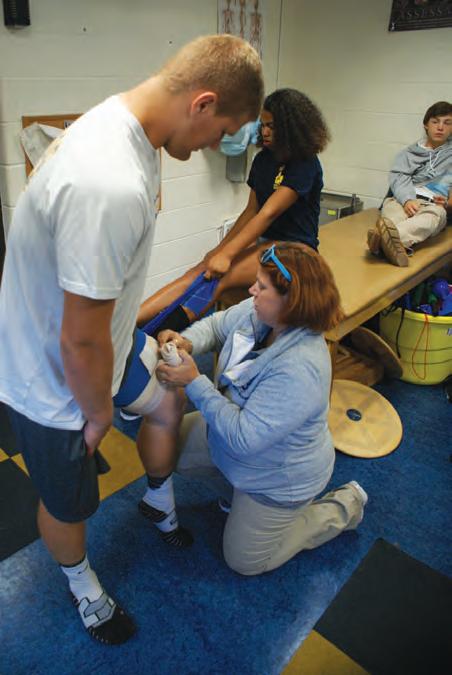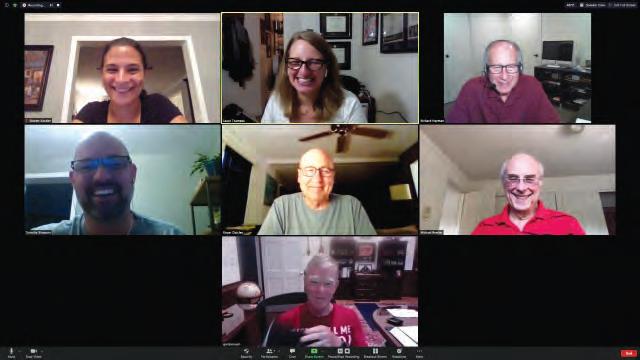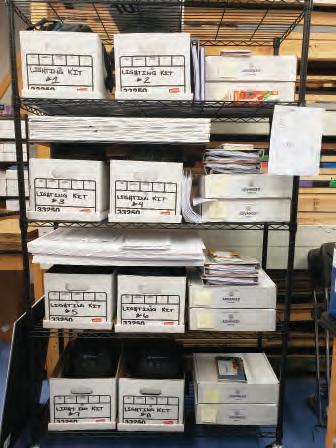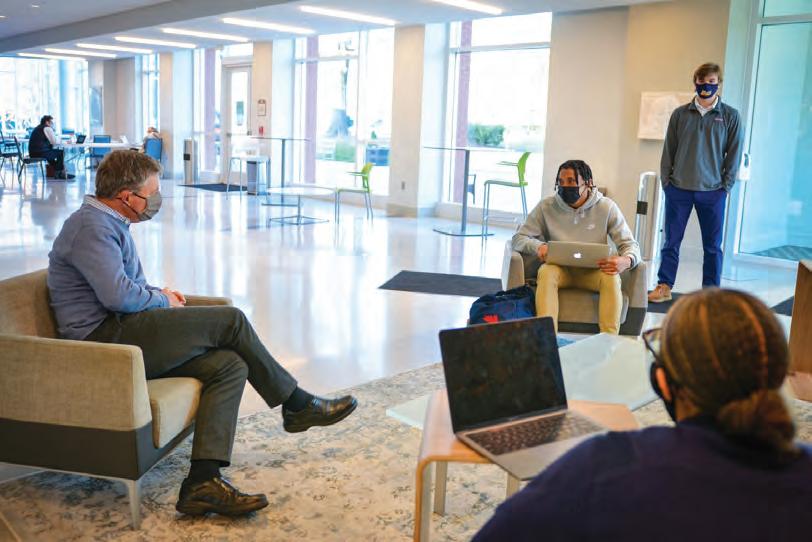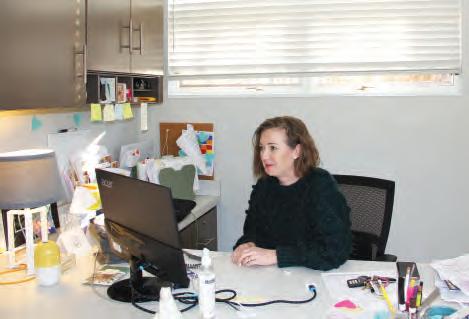
17 minute read
Arts
Thinking of You: Bullis Postcard Project
During the fi rst week of school, Upper School students wearing masks entered an art classroom in the Blair Family Center for the Arts. Seated several feet apart at tables divided by Plexiglas barriers, they listened as Art teacher Angela Swadling, who came to Bullis this year from Sydney, Australia, introduced herself, and then introduced the year’s fi rst project for this Upper School Painting class: creating postcards to share with Bullis employees.
Advertisement
Every year, the Upper School Visual Arts Department looks for a community-based art activity. This fall, Upper School Visual Arts Chair and Teacher Kathleen Adams, with Upper School Art Teachers Angela Swadling and Alice Shih-Kahn, challenged their students to create a new spin on postcard art. The idea originated with the #artofkindnesspostcardproject and artist Maryanne Hawes, who created postcardsized artworks and left them in random places to spread joy and share art with strangers. The Bullis postcard version was designed to surprise Bullis community members with postcard art to express gratitude for all that they do and create new connections across our community.
“How does art build community?” Swadling showed students postcards from Victorian times to now. “These were the social media of their day. Today, postcards are especially important for helping us celebrate and feel the human connection” in a world of masking, distancing, and quarantines. “Bullis has put so much energy into “You are the reason we feel comfortable to return to school.” —Ariana Wright ’21 making the school a safe place for everyone.” She asked students to notice recent changes around campus. “Think about who set up those hand sanitizer units, who placed the signs, who created the safety protocols for us to follow, and then create designs to thank them for doing that.”
Using pencils, markers, paints, collage materials—some of which came from art kits assembled by Bullis art teachers to distribute materials that might otherwise be widely shared in class—students crafted artworks on blank 4x6 inch postcards. Considering the elements of art and principles of design discussed in class, they drew inspiration from postcards, Zentangles, the world around them, and their imaginations. They thoughtfully noticed Bullis initiatives such as remote learning programs, new procedures, changes to classrooms, the Dining Hall, the lunch menu, and more.
“This is an initiative of kindness, and using art to express that,” Swadling said. Kathleen Adams agreed. “Our fervent hope is to continue this eff ort through Art Club and the National Art Honor Society, sharing artwork and a kind message with all members of the Bullis community.”
After creating the unique and beautiful cards, students wrote personalized messages of thanks and appreciation on the back, and distributed them to offi ces, classrooms, and mailboxes around campus, surprising and delighting the many recipients.
“Given the need for physical distancing, it seems more important than ever to use our artistic talents to create connections across our community,” Adams said.
Delivering Lab-based Science in COVID Conditions

By Mark Walter, Director of STEM Signature Program


“Anything for science,” they say. That is the attitude Dr. Celeste McDaniels, Upper School science teacher and department chair, takes as she prepares lab materials to drop off at her students’ houses on a Friday night. Henry Sun, a senior in McDaniels’ honors chemistry course, appreciates her eff orts. “The labs have been really good, especially since Dr. McDaniels drops off what we need to complete the lab,” he says. “It’s harder to explain the data when other people are collecting it, but I still feel like I can understand everything.” This shows the importance of a hands-on lab experience in science.
At its core, science helps us understand the mysteries of life. During the pandemic, as we live daily with the uncertainty of the coronavirus, the pursuit of scientifi c inquiry and understanding feels as real and urgent as ever, particularly in lab-based sciences.
Since March there have been ups and downs due to the pandemic, and I have noticed some things settling into two categories— changes to normal routines, and creative solutions arising out of necessity; these off er a glimpse of hope much like new seedlings taking root in the fertile soils devastated by fi re. Through challenge and hardship, the science department at Bullis has found ways to press on and inspire hope in students. And like all good scientists, Bullis faculty take necessary precautions with goggles, masks, physical distancing, clean hands—and then get into the lab!
Lower School

In Lower School Dana Miller’s 2nd grade class, students build towers out of common objects: cardboard, straws, rubber bands, without glue or tape. The challenge set by Lower School Science Teacher and STEM Coordinator Miller is to make a tower that reaches 54 centimeters. In years past, students would work in groups of two or three, but this year requires innovation. Like her Middle and Upper School counterparts, Miller created an individual set of materials for each of her students. Preparing science materials takes signifi cant time in a normal school year; this year, teachers have put in extra hours preparing personalized kits

for face-to-face and virtual students to ensure the health and safety of all.
As the 2nd grade students explore the properties of the various materials to determine the best base for their tower, a discovery emerges. “You can fi t one straw into another and put it through a hole in the cardboard!” says one young student, excited. Her peers observe what she is doing from a distance in a change to the norm.

Top: Teacher Dana Miller challenges 2nd grade students to build towers out of straws. Bottom: Close-up of student’s tower base.


Middle School

Middle School Science Teacher Chelsea Fajen’s 8th grade science seminar class faces similar challenges with materials. “This summer we thought about which labs to conduct and materials to purchase, and prepared kits to send home to students in 6th, 7th , and 8th grades,” says Fajen of the collaborative eff ort of the Middle School science team. One day, realizing that a few of her students were missing a key ingredient for next week’s lab, she drops it off on a Friday night to the surprise and pleasure of her students and their parents. “It’s worth it to keep our lab-based curriculum alive in Middle School,” she says.

Fajen walks her 6th grade class around campus to collect bacteria samples while they learn fi rst-hand about data collection and the scientifi c method. Classmates must be patient while watching another student take a precise swab from a door on campus—and patience is a good ingredient for scientifi c curiosity.

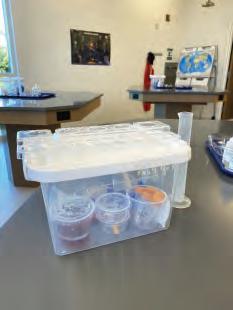
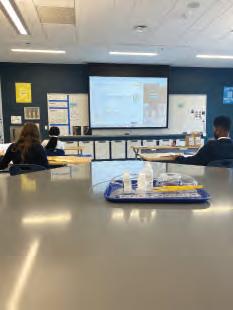
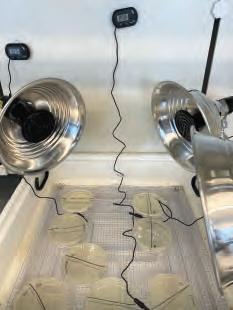
Top left: Teacher Chelsea Fajen instructs 8th graders in scientifi c data collection methods. Above: a student collects samples from a South Hall door. Below, from left: lab materials; students deposit bacteria samples in a petri dish; bacterial colonies grow under controlled conditions; in Hybrid A, half of the students are in the classroom while their peers participate via video.
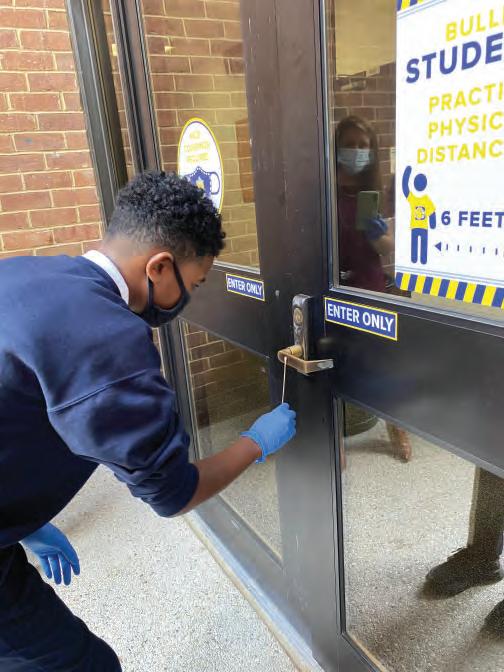
Upper School


The Upper School science squad conduct labs with students who are both in school and at home. From Physics to Food Science, Anatomy and Physiology to Biology and Chemistry, labs are happening at Bullis. Upper School teachers also created lab kits for students, distributing them on campus or dropping them off at homes. Without the regularity of previous school years and with signifi cant extra eff ort, Bullis teachers are providing lab-based experiences for their students.
In Upper School Science Teacher Dr. Daniel TerBush’s Chemistry classroom, half the students work on lab notes while the other half work individually at lab tables on a conservation of matter experiment. Working solo on any experiment presents a challenge for students, but it also provides the opportunity to become selfreliant independent learners. Handling materials carefully, students repeat the lab as needed in the allotted time, refi ning their skills further.
In Upper School Physics Teacher Dr. Badraslioglu’s Anatomy and Physiology class, students at home and in school work on dissection skills while identifying the various parts and functions of a chicken foot. Yes, Dr. B. (as he is aff ectionately known) sent home chicken feet. Anything for science!
Down in the physics lab, Upper School Science Teacher Rachel Stanoyevitch is preparing for a “bowling ball grand-prix” to allow students a kinesthetic feel for the concept of inertia. “Forces are a part of everyday life,” she says. “Inertia involves some complicated math, but students have no problem understanding and feeling the concept.”
Stanoyevitch’s remote students can choose from a menu of options for experiencing inertia: “Nickel Karate,” “Toilet Paper Roll,” “Mini Hovercraft,” the old “Cup and Tablecloth” trick, “Coin and Tumbler,” and “Pile of Books.” As in the classroom, these provide students a chance to feel and observe inertia and how it causes objects to behave.
Not all labs can be done at home. Dr. McDaniels allows her remote chemistry students to play an integral part in lab experiments by reading procedures while in-class students conduct the labs. Keeping students engaged, McDaniels calls on them to make sure they

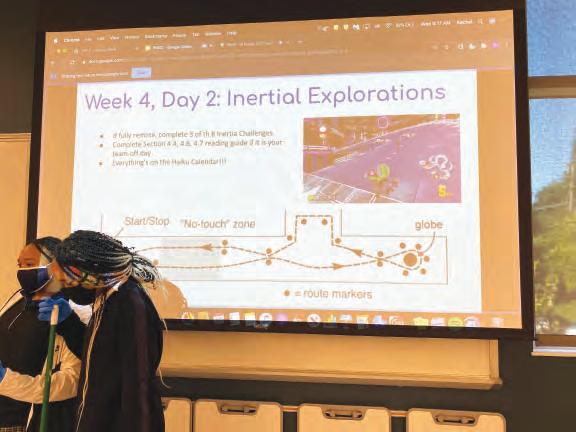
Top: an Upper School Anatomy and Physiology student dissects a chicken foot. Middle and right: bowling ball grand-prix gives Physics students a feel for inertia.

are participating in the discussion, following directions, reading procedures, and answering clearly and respectfully. “Online students can check out faster,” she says. “I just have to react faster.” Students never know who will be called on next, and their teacher’s positive attitude aff ects all as she gets smiles and giggles from remote as well as in-class students.
Is it perfect? No. Can it be frustrating? Yes, for both students and teachers.
Lab-based, hands-on science activities are just as important now as before. Despite the challenges of distributing materials, conducting classes with fewer labs than desired, and communicating through a mask to students in class and onscreen, our teachers persevere. “Students are having fun in science and learning. They appreciate the hands-on experience we off er,” says Chelsea Fajen.

“I was able to pick up my chicken foot and do the lab at home,” says one of Dr. B’s students, while sophomore Nicholas Brazier says, “I defi nitely prefer making my own observations in the lab.” Despite the many challenges to teaching this year, Bullis science teac hers are going above and beyond to engage students with hands-on science activities.
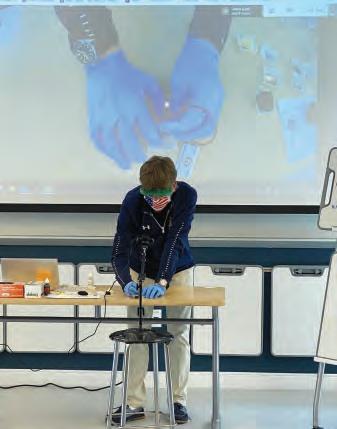

Top: Dr. McDaniels simultaneously engages students in her Chemistry classroom and those learning remotely. Below, from left: with a camera to assist, students project their labwork to classmates in person and those learning from home; students work independently in the chemistry lab; individual kits of lab materials.
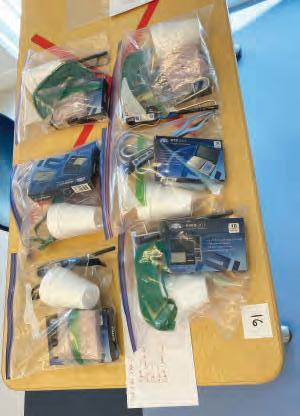
When just over a year ago it was announced that Christian Sullivan would begin serving as the seventh Head of School in Bullis’ 90 year history, one could easily guess the list of tasks he would want to tackle upon starting his tenure on July 1. Getting to know our students, our families, our faculty, and our staff ; supporting our teams; and setting a course for the next chapter in the Bullis story were just a few items that one might guess would top his list.
No one could have anticipated the challenges Mr. Sullivan would be forced to tackle, including the unprecedented decision of whether to let Bullis be the only school in the region to open its doors and let students attend classes in person. Certainly our community could not have foreseen that Mr. Sullivan would have to weigh potentially life or death considerations from health offi cials and state and local leaders that would directly impact the families and staff he was now entrusted to lead.
Fortunately, we in the Bullis community have quickly discovered no one could have navigated this challenge and helped put Bullis in a better place to succeed than Christian Sullivan. Over these short but pivotal months, Mr. Sullivan has led Bullis students and families with a determination to ensure education is a priority above all else, asking for the community to trust him and his team to open safely for the 2020-2021 academic year. Classrooms became socially distant learning tents; parent coff ees became virtual conversations.
Mr. Sullivan communicates weekly with the community; has taken the time to meet with faculty and parents to understand their fears and needs; and he and his dog Freddy have become fi xtures in the morning at the front gates, waving and smiling underneath his mask to welcome students at the start of the day. Since Mr. Sullivan made the decision to open School on September 8, 2020, being one of the only independent schools in Maryland to do so, his immersion into the Bullis community has already proven he is a leader and educator who is dedicated to the families and staff he serves.
Mr. Sullivan has been in education for 33 years. He was born in London, raised in Kent, and holds a bachelor’s degree in education from the University of Durham, a master’s degree in educational management from the University of Bath, and a master’s degree in independent school leadership from Columbia University. He taught math, coached, and served as an administrator at independent schools in England, Kenya, Virginia, Connecticut, and Washington State. He returns to the Washington, DC area with his wife, Lisa, who was raised in Chevy Chase, Maryland and currently teaches at National Cathedral School; daughter Lexy, a graduate student

Top: Christian Sullivan greets arriving students on the fi rst day of school. Bottom: the Sullivan family, from left, son Matthew, wife Lisa, Christian, and daughter Lexy.
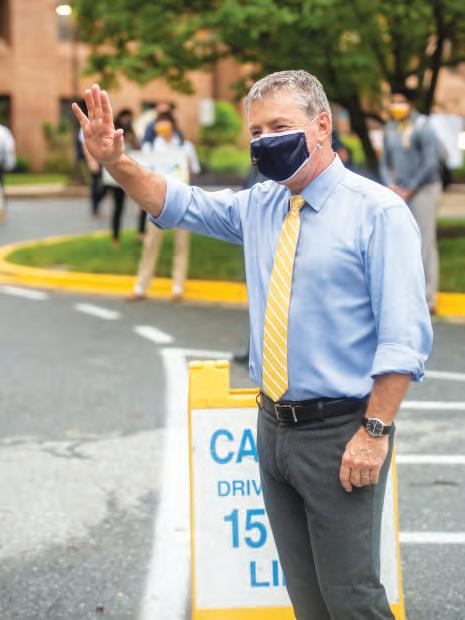
at Johns Hopkins University; and son Matthew, a sophomore at Macalester College.

Now serving in his third Head of School position, while most heads have the time to get to know their community and build a vision for their School’s future, Mr. Sullivan had to jump right in. On his opening day webinar to the current Bullis parents, Mr. Sullivan immediately addressed the importance of Equity, Inclusion, and Justice at Bullis, recognizing the importance of this work and making it one of his top priorities. Mr. Sullivan is not afraid of confrontation; in fact, he seems to look forward to a challenge. After speaking with Mr. Sullivan, he shared his vision for the School:
“I am looking forward to affi rming Bullis as a tremendous school, a pillar in the community. A School that lives its mission to provide a balanced education to its students, a place where they can stretch intellectually and reach their potential, where they can meet goals and have myriad opportunities to pursue passions in arts, athletics, academics, STEM. A place where kids grow and continue to accomplish in all those areas. When they leave Bullis, I want our students to have a generosity of spirit that feeds their compassion and their respect for others.”
As we enter into the second half of the School year, we will continue to face COVID-19 challenges, managing the eff ects it has had on academics and on the community. But we are proud that Mr. Sullivan has done such an amazing job and feel confi dent he will continue to do so. His governance is welcomed and his “lean in” attitude a ray of sunshine. The Bullis community welcomes Mr. Sullivan and his family and we look forward to a bright future.

Top left: Christian commutes to his Discovery Center offi ce; top right, Christian meets with students in his offi ce; bottom: Freddy Sullivan joins Christian and Sam Thomas ’12 from Security for a morning welcome.
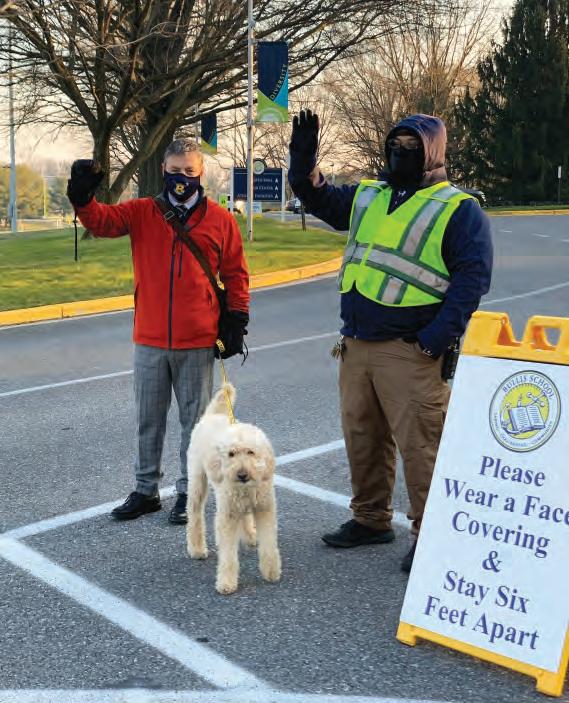
Focus on Equity, Inclusion, and Justice
By Bobby Horsey, Elise Kohan, and Bryan Whitford, Equity, Inclusion, and Justice Subcommittee Co-chairs
Bullis identifi es diversity as one of its core institutional values. You will see references to this value in signs and banners around campus, and even etched into the stairs of the Discovery Center. And yet, diversity is just part of the larger equity, inclusion, and justice conversation that is taking place across the campus.
Established as a task force in Fall 2010 to analyze and address issues of diversity on the Bullis campus, this group is now a permanent committee which spearheads the equity, inclusion, and justice work at Bullis. Over the years the committee pursued these goals by hosting student conferences, hosting professional development for faculty, organizing programming for students, and reviewing curriculum.
This year the school-wide Equity, Inclusion, and Justice (EIJ) Committee will modify its approach to lend more focus on a series of dedicated topics. Co-chaired by Bullis faculty members Elise Kohan, 5th grade teacher; Bobby Horsey, Middle School social studies teacher; and Bryan Whitford, Upper School world languages teacher, the Equity, Inclusion, and Justice Committee included the creation of subcommittees to provide both dedicated space and to turn to the deeper discussion of specifi c issues.
Several of the EIJ subcommittees include: Equity and Justice during Hybrid & Remote Learning; The 2020 Election: Before & After; and Black Lives Matter @Bullis. These subcommittees meet monthly under the larger umbrella of the EIJ committee to talk about, learn, and develop ways to incorporate a more equitable Bullis within these themes/topics. Co-Chairs of the subcommittees volunteer their time to lead a subject of which they are passionate and hope to make change within the community. The Hybrid & Remote Learning subcommittee will have the opportunity to examine education terms that were thrust upon the country back in the spring and have since become household references. Yet despite these terms’ ascendance to the national lexicon there remains uncertainty as to what they truly mean and how they impact education. What factors might we take into account during the hybrid and remote learning experiences? Are there best practices or policies to consider?
The 2020 Election Before & After subcommittee is taking a deeper look into the role of civil discourse as we head into this year’s election. Rather than focusing on right versus wrong this group has expressed an interest in developing resources that will facilitate a discourse that honors and respects multiple viewpoints. For this reason it is important to not focus solely on this election but also cultivate a culture of civic discourse afterward. The committee assembled election resources to share with faculty across the divisions and also organized faculty training on how to conduct civil discourse with students. Black Lives Matter @Bullis provides a space for subcommittee members to share their personal experiences, learn how to recognize biases, and accept students’ and faculty’s feelings about various prejudices that they have encountered at Bullis. By doing so we will be able to confront racial issues, become visible advocates for change, and be committed to making a diff erence through developing outreach programs and initiatives that address these concerns.
The Equity, Inclusion, and Justice Committee has been an integral part of the Bullis community as we continue to maintain an equitable community. This is a continuous process and one that will create an inclusive environment where all community members feel empowered to bring their true selves each day to our campus. At the same time this process also requires us to examine areas in which we can do better. For this reason we hope that our subcommittee works this year will allow our community to have deeper conversations that will provide paths forward to building a stronger Bullis.

